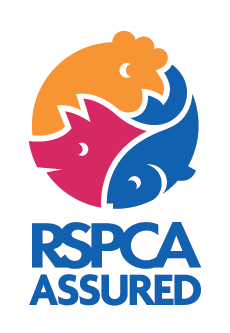My First Visit to a Commercial Pig Farm
School holidays in my family used to revolve around visits to farms (as well as wildlife parks and nature reserves). We were a very animal-centric household and my parents had their own smallholding where they kept chickens, ducks and geese.
As an adult, I went on to study marketing food and drink at university, so when I started at RSPCA Assured as marketing manager this April, I thought I already knew loads about farming and food production.

Commercial Farming
But as it turns out, petting farms, a couple of hundred chickens and textbooks can only go so far in preparing you for the world of commercial farming! So, when the opportunity arose to accompany one of the RSPCA Assured senior assessors, Sue McCabe, to an outdoor pig breeding unit on the Suffolk coastline, I jumped at it.
We were lucky to be visiting the farm on a warm spring day; the sky was blue, and there was a cool sea breeze.
The first thing that struck me about the farm as Sue began her assessment was how few pigs there were.
Looking around the site, which spanned multiple fields, I could see small groups of pigs enjoying the weather together; exploring in the soil, wallowing in mud (and occasionally in water troughs!) socialising with one another, or resting in the shade of a variety of tents and arcs (half-cylinder or triangular prism-shaped huts).
The farm manager explained this is intentionally quite a small herd (800 animals) - allowing for more individual management of the pigs’ housing, welfare and diets.
Although they are outdoors, the pigs don’t literally have “free-range” of the farm (something that is often misunderstood) - that would be impossible to manage and actually quite dangerous.
Individual Groups
Instead, they are organised into their own large patches of field, according to their size, personality, and status - i.e. gilts (pigs who have not yet been mated) and dry sows. Did you know that pregnant pigs are called ‘dry sows’ and those giving birth are called ‘farrowing sows’?
Separating them into similar groups like this helps to circumvent things like bullying and allows the farmer to keep a closer eye on their health and individual needs, adjusting their food, and so on, accordingly.
Food is very carefully managed to make sure that pigs get all the nutrients and vitamins they need. They are also given vaccinations against diseases, which means antibiotic use can be kept to a minimum and only administered when necessary to treat injuries and illnesses.
For some pigs - particularly those who have been unwell, had difficult pregnancies, or other issues, or who are farrowing, there is plenty of room to give them their own space. For farrowing pigs, having individual space to nest is more natural and relaxing for them so they are always given their own space.
As Sue closely inspected the pigs and their surroundings, carefully checking their behaviours and condition, I chatted to the farm manager who told me that some pigs even have preferences about the kind of arc they like; some prefer the half-cylinder type while others like the triangular prisms.
Farrowing pigs, for example, tend to prefer the triangular ones! These are filled with fresh straw for nesting in and then fitted with a fender - a low wall around the outside of the door that allows piglets outside for fresh air but stops them from getting lost.
As you can see from the pictures I took during the visit, the pigs had thoroughly turned over the ground in the occupied fields. They're famous for ‘rooting’ (digging with their noses), chewing and pawing, so although fields start out covered in grass, maize, turnips and other plants, this is all eaten and dug up in a short time.
Because of this, the pigs are rotated around different fields to give the ground time to recover and regrow.
But even when the pigs have eaten all the plants within reach, there are still things to keep them occupied.
Straw-Based System
It's a requirement of the RSPCA welfare standards that pigs have a bedded lying area with a solid floor and suitable enrichment. On the farm I visited, this means lovely straw beds in the arcs, bales of hay for the pigs to interact with and straw flooring for the piglets.
Once the piglets have reached a certain size and are weaned from their mothers, they're moved indoors to help the farmer keep a close eye on their health and development.
I met a number of piglets during the assessment and watched them play with each other in the straw. Sue told me that one of the key assessment criteria is observing how pigs interact with each other and with their environment, and it was clear to me that these piglets were both happy and curious.
Extensive Knowledge
I could tell from our conversations with the farm manager that he cared very much about his animals’ wellbeing.
Sue asked him complex questions about the techniques and systems used at the farm and the reasons for doing so.
With more than thirty years of experience, it was obvious that he had extensive knowledge about pig farming and was keen to stay on top of the latest developments by working closely with vets, his team and others in the industry.
At the end of our tour, Sue checked all the farm’s documentation to prove that they had been properly following the RSPCA standards with regard to food, medicine, staff training and so on. After a discussion about Sue’s findings, the farm passed its assessment and it was time to take our leave.
On my drive home, I passed several pig farms and noticed for the first time how close the arcs were to one another compared to the spacious system I’d just seen.

